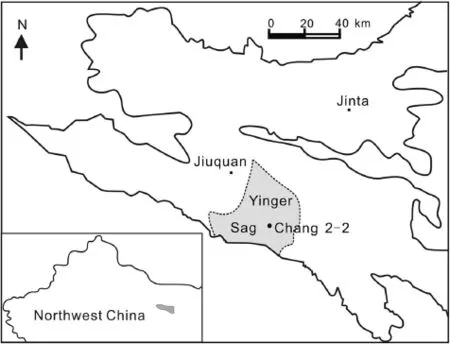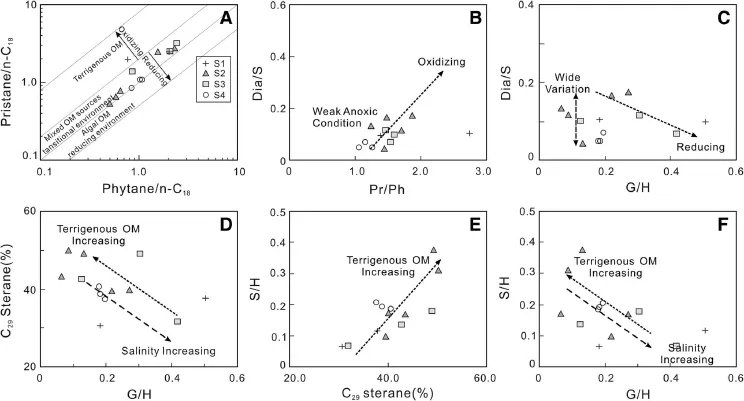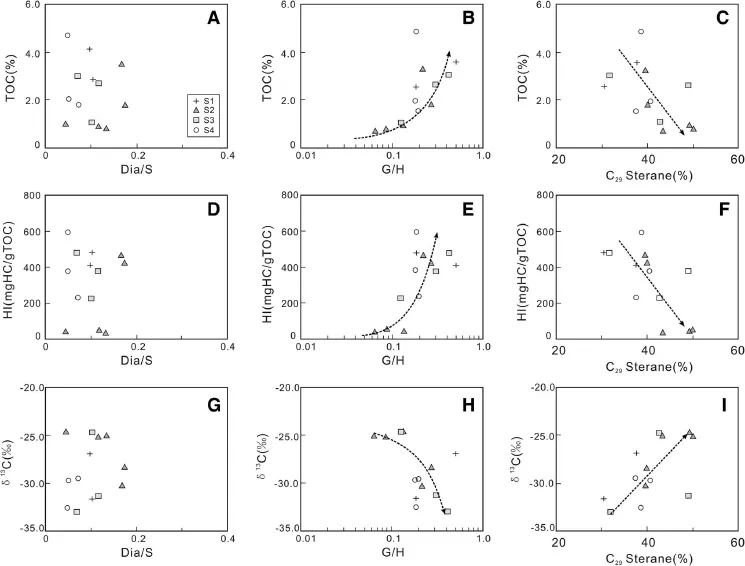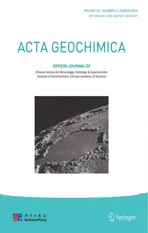Organic matter enrichment in the first member of the Xiagou formation of the lower Cretaceous in the Jiuquan Basin,China
2016-04-18LixinPeiGangGaoWenzheGangZhilongHuangGuofuMaZhimingYangJianjunChen
Lixin Pei·Gang Gao·Wenzhe Gang·Zhilong Huang·Guofu Ma· Zhiming Yang·Jianjun Chen
Organic matter enrichment in the first member of the Xiagou formation of the lower Cretaceous in the Jiuquan Basin,China
Lixin Pei1·Gang Gao1·Wenzhe Gang1·Zhilong Huang1·Guofu Ma2· Zhiming Yang2·Jianjun Chen2
DOI 10.1007/s11631-015-0082-2
The sources and enrichment of organic matter in a sediment core in the first member of the Xiagou Formation(K1g1)from the Chang 2-2 borehole of the Jiuquan Basin,NW China,have been examined using Rock-Eval,maceral,carbon isotopes and biomarker data.This data indicates that highly variable organic matter sources and preservation conditions in response to climate change. TOC content,HI,and δ13C value were strongly correlated with the abundance of gammacerane,woody organic matter content,steranes/hopanes ratio,and C29sterane content.This correlation demonstrates the importance that the control of the salinity of the depositional environment and organic matter sources can have upon the enrichment,type,and carbon isotopic composition of organic matter.In the Jiuquan Basin's relatively high temperature and arid climate,high salinity lakes with high primary productivity of algae,planktons,and bacteria,and good organic matter preservation conditions(anoxic bottom water)resulted in the enrichment of isotopically-light algae-bacterial organic matter.In the Jiuquan Basin's regions with a relatively low temperature and wet climate,fresh lakes with low primary productivity of algae,planktons,and bacteria received significant terrigenous high plants input,resulting in the deposition of a low abundance of isotopically heavier terrestrial organic matter.
Enrichment·Organic matter·Lacustrine· Lower Cretaceous·Jiuquan Basin
1 Introduction
The Jiuquan Basin is a petroliferous basin in China.It contains a series of lacustrine sediments deposited during the early Cretaceous.This succession of lacustrine sediments preserves abundant paleoenvironmental information,which is important for understanding the mechanism of organic matterdeposition in response to regionalcontinental climate evolution.A considerable amount of studies on lake systems have resulted in variable lacustrine source rock models,such as the hypersaline lake model(Kirkland and Evans 1981),the large deep anoxic lake model(Demaison and Moore 1980),the oligotrophic mesosaline alkaine closed lake model(Kelts 1988),the meromictic/oligotrophic tropical/humid lake model(Talbot 1988),and the moderately deep tropical lake model(Katz 1990).Numerous studies of organic matter deposition in relation to Cretaceous climate and environments are based on marine sediments(Jenkyns 1980;Barron 1983;Arthur et al.1988;Huberetal.2002;Wagneretal.2008;Wagreich etal.2011),but there are few published studies regarding the Cretaceous continental environments and the related organic matter enrichment mechanisms(Hasegawa 1997;Hasegawa et al. 2003;Song et al.2013).In the Jiuquan Basin,two major sets of organic rich source rocks developed during the early Cretaceous:the Chijinpu(K1c)and the Xiagou(K1g1+2+3)formations.The lacustrine source rocks associated with the Chijinpu and the Xiagou Formation,respectively,were deposited in an arid to semi-arid climate based on the fossil plants and sediments(Pan et al.2006;Deng and Lu 2008). Previous organic geochemical studies on the source rocks ofthe K1c and the third member of the K1g formation(K1g3)were used for oil-source correlation based on discontinuous core and outcrop mudstone samples(Xiong et al.2006;Han et al.2007).To date,there is no systematic geochemical study on the mechanism of organic matter enrichment in response to the climate evolution in the K1g1(member 1).
The drilling of a continuous core profile from the K1g1memberin the Chang 2-2 borehole provides an opportunity for carrying out a systematic study of the source variations of organic matter and the depositional and environmental conditions.It also enables us to analyze the mechanism of organic matterdeposition in the Jiuquan Basin.Acomprehensive study ofmaceral,carbon isotopic composition oforganic matter,and biomarkers and their variation along the profile has been undertaken.The purpose of this study is to analyze the mechanismoflacustrine organic matterenrichmentin response to the climate evolution during Early Cretaceousin the Jiuquan Basin.
2 Sample collection and analytical methods
The Jiuquan Basin is located in northwestern China,and it covers an area of 22,000 km2(Pan et al.2006)(Fig.1).The Chang 2-2 borehole is situated on the Yinger Sag in the east of the Jiuquan Basin.The core samples used in this study were collected froma depth 3900 to 3990 min the Chang 2-2 borehole,for the most part covering the K1g1member.The lithology of sediments in this section is mainly grey to black mudstones,laminated mudstones,and silty mudstone.
All rock samples were cleaned with water and then dried prior to crushing and powdering.Rock-Eval analysis was performed on OGE-II according to China National Standard GB/T18602-2001.
Rocks were Soxhletextracted using chloroform:methanol(87:13)for 72 h,and the isolated extractible organic matter was separated into saturated hydrocarbons,aromatic hydrocarbons,and polars on a silica:alumina column using hexane,hexcane:dichloromethane(2:1 v:v)and dichloromethane:methanol(1:1 v:v),respectively.Saturated hydrocarbons were analyzed for biomarkers.The extracted samples were treated with HCl and HF/HCl to separate kerogen from rock minerals.The kerogen concentrates were subjected to carbon isotope and maceral analysis.
Kerogen maceralcomposition analysiswascarried outon a MPV-3 microscope-photometer.Kerogen is made into massive/powder brick polished sections and tested under oil-immersed ref l ection light.The organic maceral ratio determines fl uorescent substances(mineral bituminite and exinite)and non- fl uorescent substances under the induced blue light,and non-f l uorescentsubstancesare furtherdetermined to be either mineral or other organic matter components(vitrinite and inertinite)under common oil-immersed ref l ection light.The common oil-immersed ref l ection light conditions are objective lens×50 and eye lens×10,while the ref l ection f l uorescence conditions are exciting filter disc K510,objective lens×50,and eye lens×10.Using induced blue light with oil-immerse ref l ection light,500 points are counted to determine the composition of organic components.
Carbon isotope analysis of Kerogens was performed on a FLASH HT EA-MAT 253 IRMS according to China National Standard GB/T 18340.2-2001.Testing conditions were as follows:Carrier He(99.999%),Flow 100 ml/min,Reference 250 ml/min,Combustion Gas Oxygen(99.995%),Flow 250 ml/mim,Reactor Temp 980°C,Reactorfilling Cr2O3,reduced copper,and Ag/CobaltOxide.

Fig.1 Location of the Jiuquan Basin and the Chang 2-2 borehole

Fig.2 Variation of the K1g1member bulk,organic carbon isotopes and biomarker parameters with depth in the Chang 2-2 borehole.G/H gammacerane/C30hopane,Dia/S C27-29diasteranes/C27-29steranes,S/H C27-29steranes/C27-35hopanes,C29sterane(%)C29sterane/C27-29steranes,OM organic matter,V vitrinite,I inertinite,Sp sporinite,Cu cutinite,ED exinite debris,Alg alginite,MB mineral bituminite
GC-MS analysis of the saturate fractions was performed with a Thermo-Finnigan Trace-DSQinstrumentequipped with a HP-5MSfused silica column(60 m×0.25 mm×0.25 m). The GCoven temperature foranalysis ofthe saturate fractions was initially held at 50°C for 1 min and then programmed to 120°C at 20°C/min,250°C at 4°C/min,and 310°C at 3°C/min,and was finally held at 310°C for 30 min.
3 Results and discussions
3.1 Abundance and types of organic matter
The total organic carbon content(TOC)for the K1g1member samples from the Chang 2-2 borehole are depicted in Fig.2.According to the relative content of TOC with respect to the average TOC,the K1g1profile can be divided into four sections.Section 1(mudstones)from 3989.30 to 3984.50 m has a high TOC content(1.80-4.12%).Section 2(mudstones and silty mudstones)from 3984.50 to 3935.50 m has the lowest TOC content(0.06-3.51%,average 1.04%)but includes a few high TOC intervals. Section 3(mudstones and laminated mudstones)from 3935.50 to 3917.00 m is an organic-rich section with TOC content varying from 0.37%to 3.37%(average 2.36%). Section 4(mudstones)from 3917.00 to 3901.50 m has a lower TOC content(0.51%-4.70%,average 1.54%).
The hydrogen index(HI)varies from 38 to 597 mg HC/ g TOC and shows similar variation as that of the TOC contents(Fig.3).As depicted in Fig.3,the types oforganic matter in Sects.1 and 3 are dominantly type II and mainly type III with some type II for Sects.2 and 4.
A clear positive linear correlation between HI and TOC was observed in Fig.3b,suggesting that the abundance and type of organic matter seem to be controlled by the same factors.
3.2 Depositional environments
Pristane and phytane were identified in all samples from the K1g1member.The Pr/Ph ratio is often used as a redox indicator of depositional environment(Didyk et al.1978) but with limitations(Peters et al.2005).The Pr/Ph ratio for the K1g1member ranges from 1.06 to 1.88 with an average of 1.43,except for one sample(2.73)in Sect.1(Fig.4b),which falls in the range considered to be poorly indicative of redox conditions(Peters et al.2005).
The ratio of diasteranes to steranes is one of the indicators for redox conditions of depositional conditions,as oxic conditions are favorable for diasterane formation.A high diasterane/sterane(Dia/S)ratio(calculated as[total C27-C29diasteranes]/[total C27-C29steranes])often suggests an oxic depositional condition when samples are at a comparable level of thermal maturity(Peters et al.2005).Because samples from the K1g1member have similar Tmax(maturity)and lithology,the diasterane/ sterane ratio can be interpreted as an indication of redox conditions.As shown in Fig.4b,the diasterane/sterane ratio is low and varies from 0.04 to 0.18(average 0.10),suggesting reducing conditions.

Fig.3 Variation of Rock-Eval hydrogen index with Tmax(a)and TOC(b)for the K1g1 member samples

Fig.4 Correlation between various biomarker parameters ref l ecting organic matter input and/or depositional environments in the K1g1member. Abbreviations for biomarker parameters are explained in Fig.2
Pr/n-C17and Ph/n-C18ratios have been widely used as indicators of depositional environment and organic matter input(Peters et al.1999;Hanson et al.2000;Duan et al. 2008).On the Pr/n-C17vs.Ph/n-C18plot,samples from different source rock intervals all fall in the mixed organic matter sources transitional environment fields(Fig.4a).
Gammacerane was detected in all samples in the K1g1member and shows similar variation as that of the TOC contents,with its gammacerane index(gammacerane/C3017α(H),21β(H)hopane)ranging between 0.07 and 0.50 with an average of 0.22(Figs.2,5).Gammacerane is widely considered to form by reduction of tetrahymanol in bacterivorous ciliates,which occurs at the interface between oxic and anoxic zones in stratified water columns(Sinninghe Damste´et al.1995).An abundance of gammacerane is usually considered to indicate the presence of stratified water columns(Sinninghe Damste´et al.1995;Peters et al.2005).Although hypersalinity and temperature can both result in a stratified water column,a high abundance of gammacerane is mostly found in evaporitic or high salinity environments(Fu et al.1990;Ritts et al.1999;Hanson et al.2000;Summons et al.2008).As shown in Fig.4c,a high abundance of gammacerane combined with low Dia/S suggests stable salinity-stratified water column with anoxic bottom water conditions,while a low abundance of gammacerane with variable Dia/S suggests that unstable stratified water column occurred due to a temperature gradient(e.g.Bohacs et al.2000),which resulted in variable redox conditions in low salinity water.This is evidenced by the fact the alternating beds mudstones and silty mudstones occurred in Sect.2,revealing alternating deposition environments.Lamellar mudstones and mudstones occurred in Sect.3,suggesting relatively stable deposition environments.
3.3 Organic matter sources
The compositions of organic matter in the K1g1member are mainly algae-bacterial organic matter(AB,including alginite and mineral bituminite),varying from 30.7%to 90.7%(average 62.9%).The relative content of terrigenous high plant organic matter(TPH,including vitrinite,inertinite,sporinite,cutinite,and exinite debris)is variable but usually low(Fig.2).This suggests important contributions from algae,planktons and bacteria,and variable terrigenous high plant input(Powell et al.1990;Xiao and Jin 1990;Ercegovac and Kostic´2006).
Sterane distribution has the potential to ref l ect the primary producer in marine and lacustrine systems(e.g. Volkman 1986;Knoll et al.2007;Sepu´lveda et al.2009;Hao et al.2011).While C28steranes are associated with specific phytoplankton types(e.g.Volkman et al.1998),C27steranes mainly originate from phytoplankton and metazoa,and C29steranes mainly derive from terrigenous higher plants(e.g.Volkman 1986;Huang and Meinschein 1979).C27-29steranes/C27-35hopanes(S/H)are also used to indicate input of eukaryotic(mainly algae and high plants)versus prokaryotic(bacteria)organisms(e.g. Peters and Moldowan 1993;Hanson et al.2000).As shown in Fig.4d-f,S/H increases with the rise of C29sterane abundance,and C29sterane content and S/H increase with the decrease of G/H,suggesting high S/H was caused by terrigenous higher plant contribution and that high salinity was favorable for bacterial mats,resulting in low S/H.
The δ13C of total organic matter ranges from-33.0‰to-24.6‰(Fig.2),but it shows significantly higher values in Sect.2 compared to the other sections.As shown in the Fig.6,the δ13C value increases with the increasing C29sterane abundance,suggesting terrigenous organic matters have high δ13C values than algal-sourced organic matter in Cretaceous,which is consistent with the previous studies(Dumitrescu and Brassell 2006;Gro¨cke et al.2003;Yans et al.2010).
Samples from Sect.3 have high AB content and low THP content,and combined with low abundance of C29sterane,low S/H,and light δ13C,they suggest important contributions from algae,phytoplankton and bacteria(Fig.2).In contrast,samples from Sects.2 and 4 have relatively high THP content and low AB content,and combined with high abundance of C29sterane,high S/H and heavy δ13C,this indicates an important contribution from terrigenous high plants(Fig.2).
3.4 Mechanism of organic matter accumulation in response to the climate
Studies of the fossil plants and sediments show that the lacustrine source rocks associated with the Xiagou Formation were deposited in the arid and semi-arid climate(Pan et al.2006;Deng and Lu 2008).Both the accumulation and type of organic matter are controlled by the same factors(Fig.3a).Although the number of samples subjected to the maceral,isotopic,and molecular analysis is limited,TOC and HI have obvious correlations with organic matter biomarker parameters,depositional environment biomarker parameters,maceral and carbon isotopic composition(Fig.6).Therefore,TOC and HI have the potential to ref l ect the enrichment and source input of organic matter,and the depositional environments that
form in response to the evolution of the paleoclimate and abundant samples subjected to Rock-Eval analysis were effectively used to analyze the mechanism of lacustrine organic matter combined with limited maceral,molecular,and isotopic analysis.

Fig.5 Representative m/z 191 mass chromatograms showing variation in the composition of terpanes through the Chang 2-2 borehole profile
TOC,HI and δ13C are poorly correlated with Dia/S(Fig.6a,d.g)but well correlated with G/H(Fig.6b,e,h)and C29sterane abundance(Fig.6c,f,i),which seems to suggest that the enrichment of organic matter was more controlled by the salinity and organic matter source than by redox conditions in the K1g1member.The salinity of lake has an effect on the growth of bacteria,algae,planktons,and high plants,and high salinity seems to be favorable for high primary productivity of algae,planktons,and bacteria(Fig.4d,f).Some samples in Sects.2 and 4 with low G/H and low Dia/S have low TOC,suggesting that the fresh lakes with stratified water(low G/H and low Dia/S)resulting from temperature gradient(e.g.Bohacs et al. 2000)had good organic matter preservation conditions. They also had low primary productivity of algae,planktons,and bacteria in the fresh waters and received significant terrigenous high plants input,resulting in low TOC,heavy δ13C,and low content of ABOM in Sects.2 and 4(Fig.2).Comparatively,the relatively high salinity water had both high primary productivity of algae,planktons,and bacteria and good organic matter preservation conditions(low Dia/S)in Sects.1 and 3,resulting in high TOC,light δ13C,and high ABOM content in Sects.1 and 3(Fig.2).
Both the primary productivity and salinity of lakes can be well interpreted on the paleoclimate evolution.In the relatively high temperature and arid climate,lakes had high salinity,high primary productivity of algae,planktons,and bacteria,and good organic matter preservation conditions,resulting in high TOC,light δ13C and high ABOM content(Sects.1 and 3 in Fig.2).Comparatively,in the relatively low temperature and wet climate,lakes had low salinity,low primary productivity of algae,plankton,and bacteria,and they received significant terrigenous high plants input,thus resulting in low TOC,heavy δ13C,and low content of ABOM(Sects.2 and 4 in Fig.2).

Fig.6 Correlation between TOC,HI,kerogen δ13C and maceral compositions for the K1g1member samples,showing the controlling factors of accumulation and type of organic matter.Abbreviations for biomarker parameters are explained in Fig.2
4 Conclusions
This analysis demonstrates that variations of TOC,HI,maceral composition,and carbon isotopic composition of total organic matter and biomarker parameters for samples from the K1g1member in the Chang 2-2 borehole mainly ref l ect the enrichment and source inputs of organic matter and depositional conditions in response to the climate evolution.Sections 1 and 3 with high TOC,HI,algaebacterial organic matter content and light δ13C deposited in high salinity lakes with high primary productivity of algae,planktons and bacteria and good organic matter preservation conditions in the relatively high temperature and arid climate.Sections 2 and 4 with low TOC,HI,and algaebacterial organic matter content,and heavy δ13C deposited in less saline lakes with low primary productivity of algae,planktons and bacteria in relatively wet climate.The enrichment and type of organic matter was controlled by the primary productivity and preservation conditions in response to the climate evolution during the period of the K1g1member deposition in the Jiuquan Basin.
Acknowledgments This study is financially supported by CNPC Major Science and Technology Project(NO.2012E330)and CNPC Fourth Petroleum Resources Assessment(NO.2013E-050209).We thank Yumen Oilfield,CNPC,for kindly providing background geological data.The authors are grateful to anonymous reviewers for their constructive comments and helpful suggestions,which helped us to significantly improve the manuscript.
Arthur MA,Dean WE,Pratt LM(1988)Geochemical and climatic effects of increased marine organic carbon burial at the Cenomanian/Turonian boundary.Nature 335(6192):714-717
Barron EJ(1983)A warm,equable Cretaceous.the nature of the problem.Earth-Sci Rev 19(4):305-338
Bohacs KM,Carrol AR,Neal JE,Mankiewicz SJ(2000)Lake-basin type,source potenial,and hydrocarbon character.An integrated sequence-stratigraphic-geochemical framework.In:Gierlowski-Kordesch EH,Kelts KR(eds)Lake basins through space and time.AAPG Stud Geol 66:3-34
Demaison GJ,Moore GT(1980)Anoxic environments and oil source bed genesis.AAPG Bull 64(8):1179-1209
Deng SH,Lu YZ(2008)Fossil Plants from Lower Cretaceous of the Jiuquan Basin,Gansu,Northwest China and their palaeoclimatic implications.Acta Geol Sin 82(1):104-113(in Chinese)
Didyk BM,Simoneit BRT,Brassell SC(1978)Organic geochemical indicators of paleoenvironmental conditions of sedimentation. Nature 272:216-222
Duan Y,Wang CY,Zheng CY,Wu BX,Zheng GD(2008)Geochemical study of crude oils from the Xifeng oilfield of the Ordos basin,China.J Asian Earth Sci 31(4-6):341-356
Dumitrescu M,Brassell SC(2006)Compositional and isotopic characteristics of organic matter for the early Aptian Oceanic Anoxic Event at Shatsky Rise,ODP Leg 198.Palaeogeogr Palaeoclimatol Palaeoecol 235(1-3):168-191
Ercegovac M,Kostic´A(2006)Organic facies and palynofacies: nomenclature,classification and applicability for petroleum source rock evaluation.Int J Coal Geol 68:70-78
Fu J,Sheng G,Xu J,Eglinton G,Gowar AP,Jia R,Fan S,Peng P(1990)Application of biological markers in the assessment of paleoenvironments of Chinese non-marine sediments.Org Geochem 16(4-6):769-779
Gro¨cke DR,Price GD,Ruffell AH,Mutterlose J,Baraboshkin E(2003)Isotopic evidence for Late Jurassic-Early Cretaceous climate change.Palaeogeogr Palaeoclimatol Palaeoecol 202(1):97-118
Han Y,Zhang L,Han X,Yang Z(2007)Classification of crude oils in Yinger Sag and its exploratory significance.Xinjiang Petroleum Geol 28(2):146-149(in Chinese)
Hanson AD,Zhang S,Moldowan JM,Liang D,Zhang B(2000)Molecular organic matter geochemistry of the Tarim Basin,Northwest China.AAPG Bull 84:1109-1128
Hao F,Zhou X,Zhu Y,Yang Y(2011)Lacustrine source rock deposition in response to co-evolution of environments and organisms controlled by tectonic subsidence and climate,Bohai Bay Basin,China.Org Geochem 42:323-339
Hasegawa T(1997)Cenomanian-Turonian carbon isotope events recorded in terrestrial organic matter from northern Japan. Palaeogeogr Palaeoclimatol Palaeoecol 130:251-273
Hasegawa T,Pratt LM,Maeda H,Shigeta Y,Okamoto T,Kase T,Uemura K(2003)Upper Cretaceous stables carbon isotope stratigraphy of terrestrial organic matter from Sakhalin,Russian Far East:a proxy forthe isotopic composition ofpaleoatmospheric CO2.Palaeogeogr Palaeoclimatol Palaeoecol 189:97-115
Huang W,Meinschein WG(1979)Sterols as ecological indicators. Geochim Cosmochim Acta 43(5):739-745
Huber BT,Norris RD,Macleod KG(2002)Deep-sea paleotemperature record of extreme warmth during the Cretaceous.Geology 30(2):123-126
Jenkyns HC(1980)Cretaceous anoxic event from continents to oceans.J Geol Soc Lond 137(2):171-180
Katz BJ(1990)Controls on distribution of lacustrine source rocks through time and space.In:B.J.Katz(ed),Lacustrine basin exploration:case studies and modern analogs.AAPG Memoir 50:61-76
Kelts K(1988)Environments of deposition of lacustrine petroleum source rocks:an introduction.In:Fleet AJ,Kelts K,Talbot MR(eds)Lacustrine petroleum source rocks.Geol Soc Spec Publ 40:3-26
Kirland DW,Evans R(1981)Source-rock potential of evaporitic environment.AAPG Bull 65(2):181-190
Knoll AH,Summons RE,Waldbauer JR,Zumber JE(2007)The geological succession of primary producers in the oceans.In: Falkowski P,Knoll AH(eds)The evolution of primary producers in the sea.Acdemic Press,Boston,pp 133-163
Pan L,Xie J,Li M,Zheng M(2006)Cretaceous-Cenozoic regional tectonic evolution in the Jiuquan Basin and petroleum exploration.Oil Gas Geol 27(1):62-69(in Chinese)
Peters KE,Moldowan JM(1993)The biomarker guide:interpreting molecular fossiles in petroleum and ancient sediments.Prentice-Hall,Upper Saddle River,p 363
Peters KE,Fraser TH,Amris W,Rustanto B,Hermanto E(1999)Geochemistry of crude oils from eastern Indonesia.AAPG Bull 83(12):1927-1942
Peters KE,Walters CC,Moldowan JM(2005)The biomarker guide,biomarkers and isotopes in petroleum exploration and earth history.Cambridge University Press,Cambridge,p 1155
Powell AJ,Dodge JD,Lewis J(1990)Late neogene to Pleistocene palynological facies of the Peruvian continental margin upwelling,Leg 12.In:Suess E,Von Huene R(eds)Proceeding of the ocean Drilling Project.Science Results.College Station,pp 297-321
Ritts BD,Hanson AD,Zinniker D,Moldowan JM(1999)Lower-Middle Jurassic nonmarine source rocks and petroleum systems of the northern Qaidam Basin,northwest China.AAPG Bull 83(12):1980-2005
Sepu´lveda J,Wendler J,Leider A,Kuss H,Summons RE,Hinrichs K(2009)Molecular isotopic evidence of environmental and ecological changes across the Cenomanian-Turonian boundary in the Levant Platform of central Jordan.Org Geochem 40(5):553-568
Sinninghe Damste´JS,Kenig F,Koopmans MP,Ko¨ster J,Schouten S,Hayes JM,de Leeuw JW(1995)Evidence for gammacerane as an indicator of water column stratification.Geochim Cosmochim Acta 59(9):1895-1900
Song Z,Qin Y,George SC,Wang L,Guo J,Feng Z(2013)A biomarker study of depositional paleoenvironments and source inputs for the massive formation of Upper Cretaceous lacustrine source rocks in the Songliao Basin,China.Palaeogeogr Palaeoclimatol Palaeoecol 385:137-151
Summons RE,Hope JM,Swart R,Walter MR(2008)Origin of Nama Basin bitumen seeps:petroleum derived from a Permian lacustrine source rock traversing southwestern Gondwana.Org Geochem 39(5):589-607
TalbotMR(1988)Theoriginsoflacustrine source rocks:evidencefrom the lakesoftropical Africa.In:Fleet AJ,Kelts K,TalbotMR(eds)Lacustrine petroleum source rock.Geol Soc Spec Publ 40:29-43
Volkman JK(1986)A review of sterol markers for marine and terrigenous organic matter.Org Geochem 9(2):83-99
Volkman JK,Barrett SM,Blackburn SI,Mansour MP,Sikes EL,Gelin F(1998)Microalgal biomarkers:a review of recent research developments.Org Geochem 29(5):1163-1179
Wagner T,Herrle JO,Damste JSS,Schouten S,Stasser I,Hofmann P(2008)Rapid warming and salinity changes of Cretaceous surface waters in the subtropical North Atlantic.Geology 36(3): 203-206
Wagreich M,Hu X,Sageman B(2011)Causes of oxic-anoxic changes in Cretaceous marine environments and their implications for Earth systems-an introduction.Sediment Geol 235(1-2):1-4
Xiao X,Jin K(1900)Macerals classification and their petrological characteristics of continental source rocks in China.Acta Sedimentol Sin 8(3):22-34(in Chinese)
Xiong Y,Cheng K,Ma L(2006)New source rock found in the Lower Cretaceous of the Jiuxi Depression.Acta Petroleui Sinica 27:24-27(in Chinese)
Yans J,Gerards T,Gerrienne P,Spagna P,Dejax J,Schnyder J,Storme J,Keppens E(2010)Carbon-isotope analysis of fossil wood and dispersed organic matter from the terrestrial Wealden facies of Hautrage(Mons Basin,Belgium).Palaeogeogr Palaeoclimatol Palaeoecol 291(1-2):85-105
Received:12 September 2014/Revised:2 August 2015/Accepted:10 November 2015/Published online:25 November 2015
©Science Press,Institute of Geochemistry,CAS and Springer-Verlag Berlin Heidelberg 2015
✉Gang Gao gaogang2819@sina.com;greathoper@163.com
1College of Geosciences,China University of Petroleum,Beijing,China
2Research Institute of Exploration and Development,Yumen Oilfield Company,CNPC,Jiuquan,Gansu,China
杂志排行
Acta Geochimica的其它文章
- The Moon
- Equilibrium and kinetic Si isotope fractionation factors and their implications for Si isotope distributions in the Earth's surface environments
- Study of oxygen fugacity during magma evolution and ore genesis in the Hongge mafic-ultramafic intrusion,the Panxi region,SW China
- Determination of rhenium and osmium by ICP-MS for galena and sphalerite
- Oil-source correlation of Lower-Triassic oil seepages in Ni'erguan village,Southern Guizhou Depression,China
- The inf l uence of three mangrove species on the distribution of inorganic nitrogen and phosphorus in the Quanzhou Bay estuarine wetland soils
